Family Sciuridae Gestation period 44 days | Phylum Chordata Trophic level Omnivorous Mass 400 – 600 g (Adult) | |
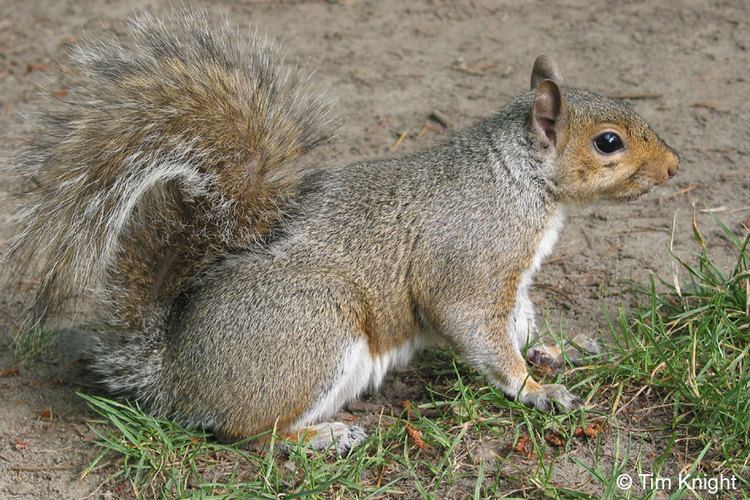 | ||
Length 23 – 30 cm (Adult, Head and body) Conservation status Least Concern (Population increasing) Similar Squirrel, Red squirrel, Tree squirrels, Fox squirrel, Rodent | ||
The squirrel eastern gray squirrel or grey squirrel sciurus carolinensis
Sciurus carolinensis, common name eastern gray squirrel or grey squirrel depending on region, is a tree squirrel in the genus Sciurus. It is native to eastern North America, where it is the biggest and ecologically essential natural forest regenerator. In Europe it is regarded as an invasive species.
Contents
- The squirrel eastern gray squirrel or grey squirrel sciurus carolinensis
- Eastern gray squirrel sciurus carolinensis on shoal creek trail in austin tx
- Distribution
- Etymology
- Description
- Behavior
- Predation
- Reproduction
- Communication
- Diet
- Habitat
- Introductions
- Displacement of red squirrels
- As food
- References
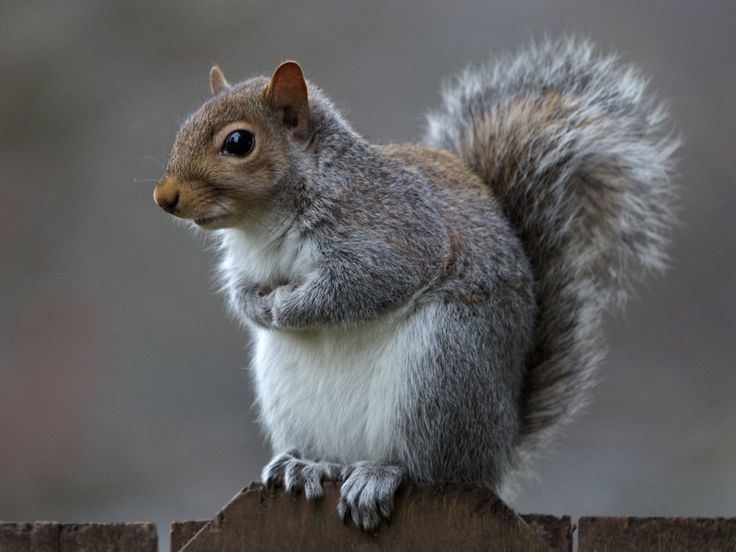
Eastern gray squirrel sciurus carolinensis on shoal creek trail in austin tx
Distribution
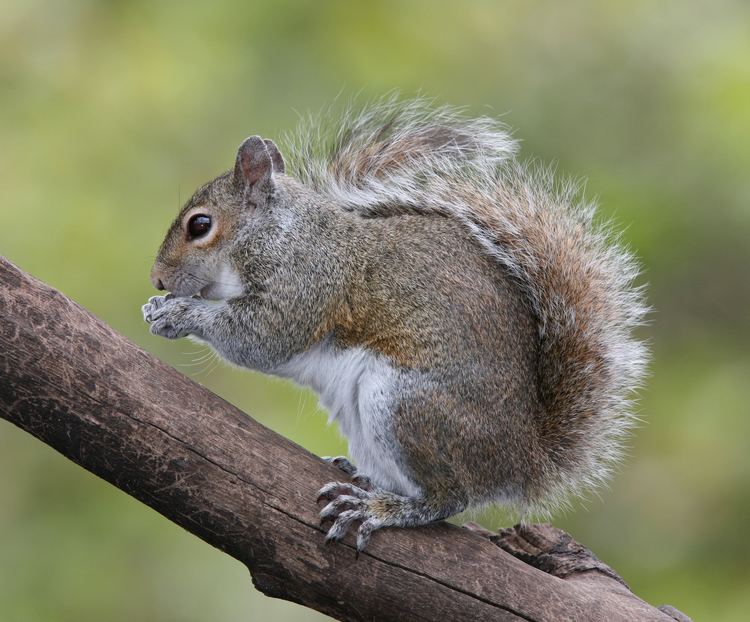
Sciurus carolinensis is native to the eastern and midwestern United States, and to the southerly portions of the eastern provinces of Canada. The native range of the eastern gray squirrel overlaps with that of the fox squirrel (Sciurus niger), with which it is sometimes confused, although the core of the fox squirrel's range is slightly more to the west. The eastern gray squirrel is found from New Brunswick to Manitoba, south to East Texas and Florida. Breeding eastern gray squirrels are found in Nova Scotia, but whether this population was introduced or came from natural range expansion is not known. It has also been introduced into Ireland, Britain, Italy, South Africa, and Australia (where it was extirpated by 1973). Eastern grey squirrels in Europe are a concern because they have displaced some of the native squirrels there. This squirrel has also been introduced to Vancouver Island in Western Canada in 1966 in the area of Metchosin and has spread widely from there. The squirrels are considered highly invasive and a threat to both the local ecosystem and the native red squirrel.
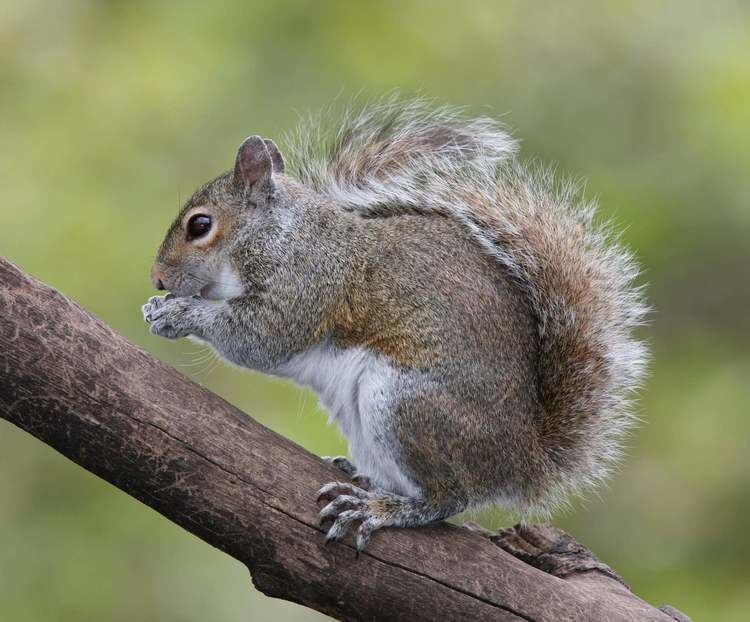
A prolific and adaptable species, the eastern gray squirrel has been introduced to, and thrives in, several regions of the western United States. The gray squirrel is an invasive species in Britain; it has spread across the country and has largely displaced the native red squirrel, S. vulgaris. In Ireland, the red squirrel has been displaced in several eastern counties, though it still remains common in the south and west of the country. That such displacement might happen in Italy is of concern, and gray squirrels might spread from Italy to other parts of mainland Europe.
Etymology
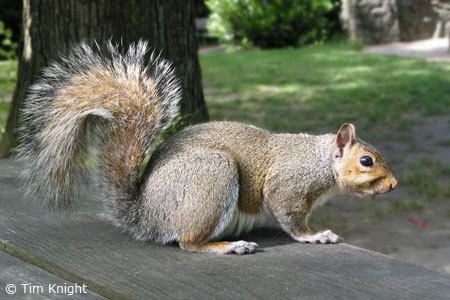
The generic name, Sciurus, is derived from two Greek words, skia, meaning shadow, and oura, meaning tail. This name alludes to the squirrel sitting in the shadow of its tail. The specific epithet, carolinensis, refers to the Carolinas, where the species was first recorded and where the animal is still extremely common. In the United Kingdom and Canada, it is simply referred to as the "grey squirrel".
Description
The eastern gray squirrel has predominantly gray fur, but it can have a brownish color. It has a usual white underside as compared to the typical brownish-orange underside of the fox squirrel. It has a large bushy tail. Particularly in urban situations where the risk of predation is reduced, both white – and black-colored individuals are quite often found. The melanistic form, which is almost entirely black, is predominant in certain populations and in certain geographic areas, such as in large parts of southeastern Canada. Genetic variations within these include individuals with black tails and black-colored squirrels with white tails. (See Tree squirrel for more information on these color variations.)
The head and body length is from 23 to 30 cm (9.1 to 11.8 in), the tail from 19 to 25 cm (7.5 to 9.8 in), and the adult weight varies between 400 and 600 g (14 and 21 oz).
The tracks of an eastern gray squirrel are difficult to distinguish from the related fox squirrel and Abert's squirrel, though the latter's range is almost entirely different from the gray's. Like all squirrels, the eastern gray shows four toes on the front feet and five on the hind feet. The hind foot-pad is often not visible in the track. When bounding or moving at speed, the front foot tracks will be behind the hind foot tracks. The bounding stride can be two to three feet long.
Behavior
Like many members of the family Sciuridae, the eastern gray squirrel is a scatter-hoarder; it hoards food in numerous small caches for later recovery. Some caches are quite temporary, especially those made near the site of a sudden abundance of food which can be retrieved within hours or days for reburial in a more secure site. Others are more permanent and are not retrieved until months later. Each squirrel is estimated to make several thousand caches each season. The squirrels have very accurate spatial memory for the locations of these caches, and use distant and nearby landmarks to retrieve them. Smell is used partly to uncover food caches, and also to find food in other squirrels' caches. Scent can be unreliable when the ground is too dry or covered in snow.
Squirrels sometimes use deceptive behavior to prevent other animals from retrieving cached food. They will pretend to bury the object if they feel that they are being watched. They do this by preparing the spot as usual, for instance digging a hole or widening a crack, miming the placement of the food, while actually concealing it in their mouths, and then covering up the "cache" as if they had deposited the object. They also hide behind vegetation while burying food or hide it high up in trees (if their rival is not arboreal). Such a complex repertoire suggests that the behaviors are not innate, and imply theory of mind thinking.
The eastern gray squirrel is one of very few mammalian species that can descend a tree head-first. It does this by turning its feet so the claws of its hind paws are backward-pointing and can grip the tree bark.
Eastern gray squirrels build a type of nest, known as a drey, in the forks of trees, consisting mainly of dry leaves and twigs. Males and females may share the same nest for short times during the breeding season, and during cold winter spells. Squirrels may share a drey to stay warm. They may also nest in the attic or exterior walls of a house, where they may be regarded as pests, as well as fire hazards due to their habit of gnawing on electrical cables. In addition, squirrels may inhabit a permanent tree den hollowed out in the trunk or a large branch of a tree.
Eastern gray squirrels are crepuscular, or more active during the early and late hours of the day, and tend to avoid the heat in the middle of a summer day. They do not hibernate.
Predation
Predators include humans, hawks, weasels, raccoons, foxes, domestic and feral cats, snakes, owls, and dogs. In its introduced range in South Africa, it has been preyed on by African harrier-hawks.
Reproduction
Eastern gray squirrels can breed twice a year, but younger and less experienced mothers normally have a single litter per year in the spring. Depending on forage availability, older and more experienced females may breed again in summer. In a year of abundant food, 36% of females bear two litters, but none will do so in a year of poor food. Their breeding seasons are December to February and May to June, though this is slightly delayed in more northern latitudes. The first litter is born in February or March, the second in June or July, though, again, bearing may be advanced or delayed by a few weeks depending on climate, temperature, and forage availability. In any given breeding season, an average of 61 – 66% of females bear young. If a female fails to conceive or loses her young to unusually cold weather or predation, she re-enters estrus and has a later litter.
Normally, one to four young are born in each litter, but the largest possible litter size is eight. The gestation period is about 44 days. The young are weaned around 10 weeks, though some may wean up to six weeks later in the wild. They begin to leave the nest after 12 weeks, with autumn born young often wintering with their mother. Only one in four squirrel kits survives to one year of age, with mortality around 55% for the following year. Mortality rates then decrease to around 30% for following years until they increase sharply at eight years of age.
Eastern gray females can rarely enter estrus as early as five and a half months old, but females are not normally fertile before at least one year of age. Their mean age of first estrus is 1.25 years. Male eastern grays are sexually mature between one and two years of age. These squirrels can live to be 20 years old in captivity, but in the wild live much shorter lives due to predation and the challenges of their habitat. At birth, their life expectancy is 1–2 years, an adult typically can live to be six, with exceptional individuals making it to 12 years.
Communication
As in most other mammals, communication among eastern gray squirrel individuals involves both vocalizations and posturing. The species has a quite varied repertoire of vocalizations, including a squeak similar to that of a mouse, a low-pitched noise, a chatter, and a raspy "mehr mehr mehr". Other methods of communication include tail-flicking and other gestures, including facial expressions. Tail flicking and the "kuk" or "quaa" call are used to ward off and warn other squirrels about predators, as well as to announce when a predator is leaving the area. Squirrels also make an affectionate coo-purring sound that biologists call the "muk-muk" sound. This is used as a contact sound between a mother and her kits and in adulthood, by the male when he courts the female during mating season.
The use of vocal and visual communication has been shown to vary by location, based on elements such as noise pollution and the amount of open space. For instance, populations living in large cities generally rely more on the visual signals, due to the generally louder environment with more areas without much visual restriction. However, in heavily wooded areas, vocal signals are used more often due to the presence of less noise and a dense canopy restricting visual range.
Diet
Eastern gray squirrels eat a range of foods, such as tree bark, tree buds, berries, many types of seeds and acorns, walnuts, and other nuts, and some types of fungi found in the forests, including fly agaric mushrooms (Amanita muscaria). They can cause damage by tearing the tree bark and eating the soft cambial tissue underneath. In Europe, sycamore (Acer pseudoplatanus L.) and beech (Fagus sylvatica L.) suffer the greatest damage.
Eastern gray squirrels have a high enough tolerance for humans to inhabit residential neighborhoods and raid bird feeders for millet, corn, and sunflower seeds. Some people who feed and watch birds for entertainment also intentionally feed seeds and nuts to the squirrels for the same reason. The squirrels also raid gardens for tomatoes, corn, strawberries, and other garden crops. Sometimes they eat the tomato seeds and discard the rest. On very rare occasions, when their usual food sources are scarce, eastern gray squirrels also prey upon insects, frogs, small rodents including other squirrels, and small birds, their eggs, and young. They also gnaw on bones, antlers, and turtle shells – likely as a source of minerals scarce in their normal diet.
Habitat
In the wild, eastern gray squirrels can be found inhabiting large areas of mature, dense woodland ecosystems, generally covering 100 acres (40 hectares) of land. These forests usually contain large amounts of dense understory vegetation that provides them sufficient amount of food sources and favorable shelters. Oak-hickory hardwood forests are preferred over coniferous forests.
Eastern gray squirrels generally prefer constructing their dens upon large tree branches and within the hollow trunks of trees. They also have been known to take shelter within abandoned bird nests. The dens are usually lined with moss plants, thistledown, dried grass, and feathers. These perhaps provide and assist in the insulation of the den, used to reduce heat loss. A cover to the den is usually built afterwards.
Close to human settlements, eastern gray squirrels are found in parks and back yards of houses within urban environments and in the farmlands of rural environments.
Introductions
The eastern gray squirrel is an introduced species in a variety of locations in western North America: in western Canada, to the southwest corner of British Columbia and to the city of Calgary, Alberta; in the United States, to the states of Washington and Oregon and, in California, to the city of San Francisco and the San Francisco Peninsula area in San Mateo and Santa Clara Counties, south of the city. It has become the most common squirrel in many urban and suburban habitats in western North America, from north of central California to southwest British Columbia. At the turn of the 20th century, the eastern gray squirrel was introduced into South Africa, Ireland, Hawaii, Bermuda, Madeira Island, the Azores, the Canary Islands, Cape Verde, Italy and the United Kingdom.
In South Africa, though exotic, it is not usually considered an invasive species owing to its small range (only found in the extreme southwestern part of the Western Cape, going north as far as the small farming town of Franschhoek), as well because it inhabits urban areas and places greatly affected by humans, such as agricultural areas and exotic pine plantations. Here, it mostly eats acorns and pine seeds, although it will take indigenous and commercial fruit, as well. Even so, it is unable to use the natural vegetation (fynbos) found in the area, a factor which has helped to limit its spread. It does not come into contact with native squirrels due to geographic isolation (a native tree squirrel, Paraxerus cepapi, is found only in the savanna regions in the northeast of the country) and different habitats.
It spread rapidly across England and then became established in both Wales and parts of southern Scotland. On mainland Britain, it has almost entirely displaced the populations of native red squirrels. On the island of Ireland, this displacement has not been as rapid because only a single introduction was made, in County Longford. Schemes have been introduced to control the population in Ireland to encourage the native red squirrels. Eastern gray squirrels have also been introduced to Italy, and the European Union has expressed concern it will similarly displace the red squirrel from parts of the European continent.
Displacement of red squirrels
In Britain and Ireland, the eastern gray squirrel is not regulated by natural predators, other than the European pine marten, which is generally absent from England and Wales. This has aided its rapid population growth and has led to the species being classed as a pest. Measures are being devised to reduce its numbers, including one plan for celebrity television chefs to promote the idea of eating the squirrels. In areas where relict populations of red squirrels survive, such as the islands of Anglesey and Brownsea, programs exist to eradicate gray squirrels in an effort to allow red squirrel populations to recover.
Although complex and controversial, the main factor in the eastern gray squirrel's displacement of the red squirrel is thought to be its greater fitness, hence a competitive advantage over the red squirrel on all measures. The eastern gray squirrel tends to be larger and stronger than the red squirrel and has been shown to have a greater ability to store fat for winter. The squirrel can, therefore, compete more effectively for a larger share of the available food, resulting in relatively lower survival and breeding rates among the red squirrel. Parapoxvirus may also be a strongly contributing factor; red squirrels have long been fatally affected by the disease, while the eastern gray squirrels are unaffected, but thought to be carriers - although how the virus is transmitted has yet to be determined. However, several cases of red squirrels surviving have been reported, as they have developed an immunity – although their population is still being massively affected. The red squirrel is also less tolerant of habitat destruction and fragmentation, which has led to its population decline, while the more adaptable eastern gray squirrel has taken advantage and expanded.
Similar factors appear to have been at play in the Pacific region of North America, where the native American red squirrel has been largely displaced by the eastern gray squirrel in parks and forests throughout much of the region.
Ironically, "fears" for the future of the eastern gray squirrel arose in 2008, as the melanistic form (black) began to spread through the southern British population. In the UK, if a "grey squirrel" (eastern gray squirrel) is trapped, under the Wildlife and Countryside Act 1981, it is illegal to release it or to allow it to escape into the wild; instead, it should be humanely destroyed.
As food
Gray squirrels were eaten in earlier times by Native Americans and their meat is still popular with hunters across most of their range in North America. Today, it is still available for human consumption and is occasionally sold in the United Kingdom. However, physicians in the United States have warned that squirrel brains should not be eaten, because of the risk that they may carry Creutzfeldt-Jakob disease.
